The History of the
Locksmith's House
| The Locksmith's House is located in a Victorian
lockmaker’s house and workshops, that are a typical example of many
of the small business premises that occupied a great deal of
Willenhall and the surrounding area.
Much of the house has been accurately restored into an
archetypal Victorian dwelling, using many of the original pieces
of furniture. Gas lighting is still installed, and once inside,
it’s possible to imagine that you are back in Victorian times.
There is also an interesting and unusual collection of locks
and keys that were locally made. The workshops still contain the
machinery to manufacture the handmade padlocks that were
produced here. They are unique, as handmade locks are now a
thing of the past, and most of the small workshops that were so
abundant in the town, have disappeared due to decay or
redevelopment. |

The Locksmith's House, 54 New Road, Willenhall, West Midlands. |
The buildings consist of a house, with
workshops on either side of a back yard.
|
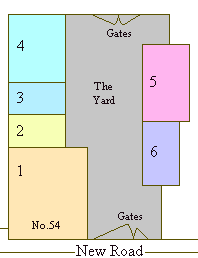
|
|
1 |
The House.
Ground floor: Parlour at the back and a front room,
which later became the shop.
First floor: Three bedrooms. |
|
2 |
Ground floor: The kitchen.
First Floor: The office. |
|
3 |
The varnish shop and family wash house. |
|
4 |
The stamping shop. |
|
5 |
The Workshop:
Ground floor: Smithy and manufacturing of parts.
First floor: Assembly. |
|
6 |
Two privies and ash pits, and later a
stable for a pony.
|
|
|
Plan of the house in 1904. |
The house and workshops were built in the
1840's, and according to the 1851 Census, the property was occupied by
Job Clark, a bolt-maker, employing twelve men. The business was listed
in Melville's directory of 1851 as follows: "Clark, Job, stamper
by new registered stamping machine, and round and flat bolt
manufacturer, New Road".
|
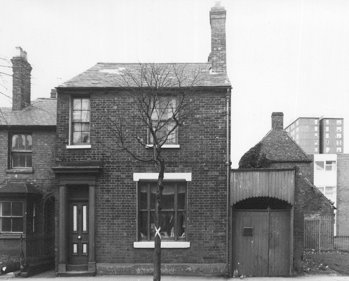
The front of the house. |
In the early years of the 20th
century, the house and workshops belonged to Job Phillips. He
decided to rent the workshops, and let them to Richard Hodson & Son,
lockmakers. Richard Hodson and Son was founded in 1792, and in 1893
it was taken over by John Hodson, who paid £47.1s.6d to his late
mother's estate for the business, shop tools and effects. The
business continued to trade under its original name and operated
from several addresses in the Willenhall area, before moving to New
Road. |
| John and his wife Sarah had
six children, consisting of one son and five daughters. Two of the
daughters, Florence and Irene, died young. The remaining children
were Edgar, Edith, Flora and Ida. In 1903, Mr. Phillips decided to
sell the house and workshops, and they were purchased by John and
Sarah, who moved into the house, with their children, in 1904.
Hodsons produced two types of padlock,
which were sold all over the world. Some of the countries that
purchased the locks were Cuba, Equador, France, Russia, and to a
lesser extent the U.K. The first type of padlock produced was
the lighter lock, which was used for securing crates to the deck
of boats, for the transfer of cargo from sea going ships to the
port. The second type of lock was the bar padlock. These were
used for such purposes as securing gates, securing cattle
compounds and had uses in prisons. |
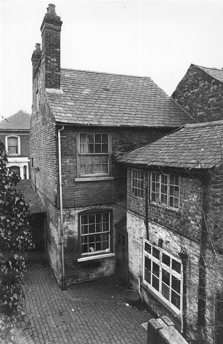
The back yard. |
|
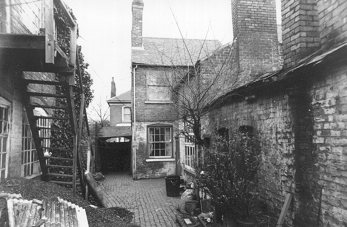
Another view of the back yard. |
The locks were made in the two
story workshop, and were varnished in the varnish shop, on the other
side of the yard. The varnish shop doubled-up as the family's
washroom and included all of the typical washing equipment of the
day. There were wash tubs, a dolly maid, a posher and a mangle. |
| John died in 1911, and his son
Edgar took over the business. He was helped his mother and sisters,
Edith and Flora. Ida married George Nicholls, who was Hodson's
cashier and clerk. Flora did a shorthand and typing course, and
worked for the Staffordshire Bolt & Nut & Fencing Company Limited,
from about 1918 to 1927. She eventually left, to join Edith in
running a small fancy drapers and general store in the front room of
their house. They traded as E.A. and F.S. Hodson. Sarah died in
1951, aged 91, and left the property to Edgar, Edith and Flora. None
of them ever married. |
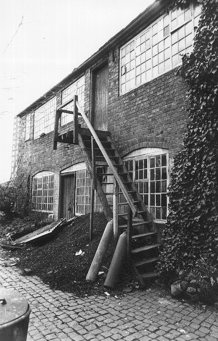
The main workshops. |
|
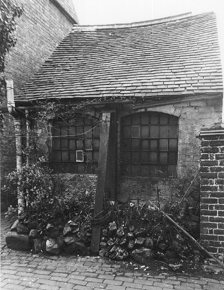
The outhouse. |
One of our society members,
Jack Knight ran a florist's shop for many years in Willenhall. Jack
knew the Hodson's well and once a year Edgar would call in to buy a
flower to wear in his buttonhole for his annual visit to Buckingham
Palace. Edgar made some of the locks that were used in the palace
and his visits were for annual maintenance. After Sarah's death the
two sisters ran the house, the shop and looked after Edgar. They
were involved in the church, politics, charitable works and amateur
operatics. Edith died in 1966, aged 75 and Edgar continued with the
business until his death in 1970, at the age of 80. Flora lived
alone in the house until she died in 1983, aged 84.
In 1983 the house and workshops were purchased by the Lock Museum
Trust, to be converted into a museum. The Lock Museum opened in
April 1987. |
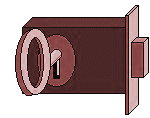
|
|
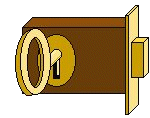
|
Return to
the beginning |
|
Proceed to
the tour
of the museum |
|










